Quilts
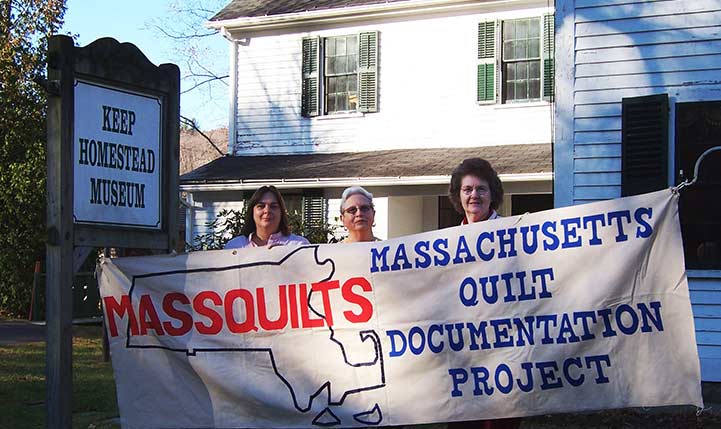 The Keep Homestead Museum Quilt Collection
The Keep Homestead Museum Quilt Collection
In 2006, the Keep Homestead Museum participated in the Massachusetts Quilt Documentation Project. Our collection of over 30 quilts and two samples were catalogued. The exact identity of each quilt-maker is not known, but all are assumed to be members of the Keep family. Our current exhibit capacity does not allow them to be fully displayed, except as noted in the captions.

Crazy quilt in Charles and Pearl’s bedroom on left, a sampling of individual squares of this quilt on right.
Layered on the bed in Charles and Pearl’s bedroom are a couple of quilts from the Keep Homestead Museum collection. The most striking is the topmost quilt, called a “crazy quilt.” This term is often used to refer to the random patchwork technique seen on this quilt. It does not actually refer to a specific kind of quilting but rather a kind of patchwork that lacks repeating motifs with seams and patches that are heavily embellished. A crazy quilt rarely has the internal layer of batting that is part of what defines quilting as a textile technique.
Because the careful geometric design of a quilt block is much less important in crazy quilts, quilters are able to use much smaller and more irregularly shaped pieces of fabric. The quilts are far more likely to use exotic pieces of fabric, such as velvet, satin, tulle, or silk and embellishments such as buttons, lace, ribbons, beads, or embroidery. In the late 1800s, naturally lightweight silk fabrics were often “weighted” with metallic salts to give them more body. These corrosive metals have damaged fabrics over the years, evidence of which is apparent in the Keep Homestead Museum crazy quilt.
Crazy quilts range from carefree and relatively easy, to extremely labor-intensive. A Harper’s Bazaar article from 1884 estimated that a full-size crazy quilt could take 1,500 hours to complete. Crazy quilting as a textile art is extremely creative and free-flowing by nature, and crazy quilters will often learn as much about specific embellishments as they will about crazy quilting itself. The quilt in Charles and Pearl’s bedroom explores a number of embroidery techniques, seen in the close ups of a few of the individual squares, and is framed by a deep pink ruffle.
Click on the thumbnails below to see the wide variety of quilting techniques represented in the collection. Included is a summary of the notes regarding the quilts pictured that was on the CD provided by the Quilt Documentation staff, according to the identification numbers they assigned.
-
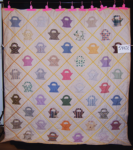
-
ID #5468 Baskets: 84″ x 90″, 11 1/4″ blocks, two layers quilted, cotton—some from 1930s, most from 1950–60s, machine and hand work, including appliqué
-
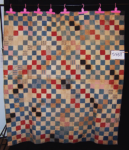
-
ID #5469 One Patch: 77 1/2″ x 82″ with 3″ blocks, three layers tied, cotton, pieced by machine
-
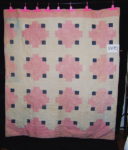
-
ID #5470 Log Cabin variation: 77″ x 85″, 11″ blocks, three layers, tied, cotton, pieced by machine
-
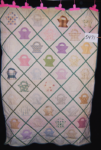
-
ID #5471 Baskets: 57″ x 83″, 10″ blocks, three layers tied, cotton, pieced by machine. This quilt is the same as ID #5468 but older. Some blocks are identical.
-
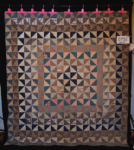
-
ID #5472 (front) Ocean Waves or Tents of Armageddon, c. 1900: reversible, 81″ x 92″, three layers tied, 9″ squares, half-square triangles, cotton, pieced by machine
-
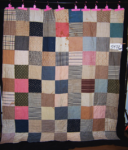
-
ID #5472 (back) Ocean Waves or Tents of Armageddon, c. 1900: reversible, 81″ x 92″, three layers tied, 4 1/2″ blocks, cotton, pieced by machine
-

-
ID #5473 Sunbonnet Sue —Documentation pages not found.
-

-
ID #5474 c. 1900: 77″ x 89″, three layers tied, 4-path in strips, cotton, pieced by hand
-
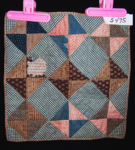
-
ID #5475 Hourglass, c.1890: 18″ x 18″, three layers quilted, cotton, pieced by hand and hand-quilted
-
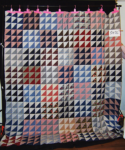
-
ID #5476 Double X, c. 1900: 92″ x 98″, top only, 13″ blocks, cotton-shirting, pieced by machine
-
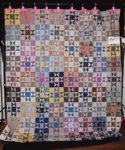
-
ID #5477 Ohio Star, assembled c.1950: 88″ x 98″, top only, cotton, older fabric—oldest from the 4th quarter of the 19th century, pieced by machine
-
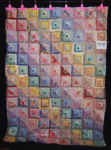
-
ID #5478 Log Cabin variation, c. 1935: 68″ x 96″, top only, cotton—some older fabrics, pieced by machine
-
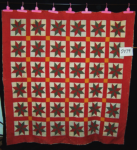
-
ID #5479 Documentation pages not found.
-
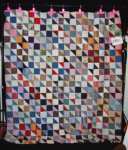
-
ID #5480 Four Patch, 1894–1950: 86 1/2″ x 94″, top only, cotton, half-square triangles, 9″ blocks, pieced by machine
-
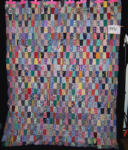
-
ID #5481 Tumbler, 1940s possibly ’50s: 74″ x 93″, top only, cotton, hand and machine work
-
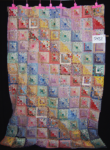
-
ID #5482 Log Cabin variation, c. 1935: 65 1/4″ x 92″, top only, cotton—similar to ID #5478
-
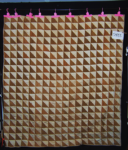
-
ID #5483 Ocean Waves, c. 1900: 80 1/2 ” x 86″, three layers tied, silk with cotton backing. Can be seen on display in Charles and Pearl’s bedroom.
-
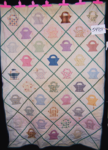
-
ID# 5484 Baskets, second quarter of 20th century: 63 1/2″ x 83 1/2″, two layers quilted, cotton—hand-quilted, some machine work, some appliqué. See also ID #5471, similar age.
-
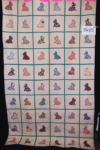
-
ID# 5485 Scottie Dogs (sitting), c. 1935: 56″ x 94″, two layers hand quilted, cotton, 9″ blocks, buttonhole embroidery. This quilt can be seen on display in the child’s bedroom. These dogs were popular in the 1930s because of Fala, President Franklin D. Roosevelt’s Scottie dog.
-
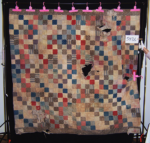
-
ID #5486 Four Patch, c. 1900: 78″ x 84″, three layers tied, cotton, machine pieced
-
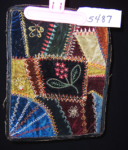
-
ID #5487 Crazy Quilt block, 1890: 10″ x 13″, two layers not tied or quilted, silk and velvet. This sampler of embroidery stitches can be seen in child’s bedroom in the doll carriage.
-

-
ID #5488 (front), c. 1900: 6 1/2″ x 20″, hand work, silk with embroidery
-

-
ID #5488 (back)
 The Keep Homestead Museum Quilt Collection
The Keep Homestead Museum Quilt Collection